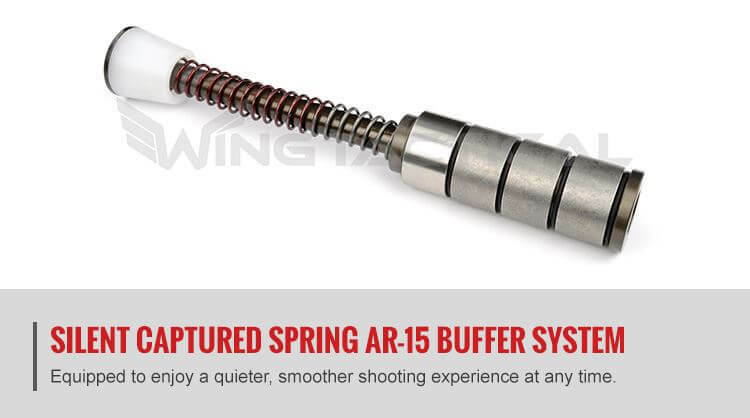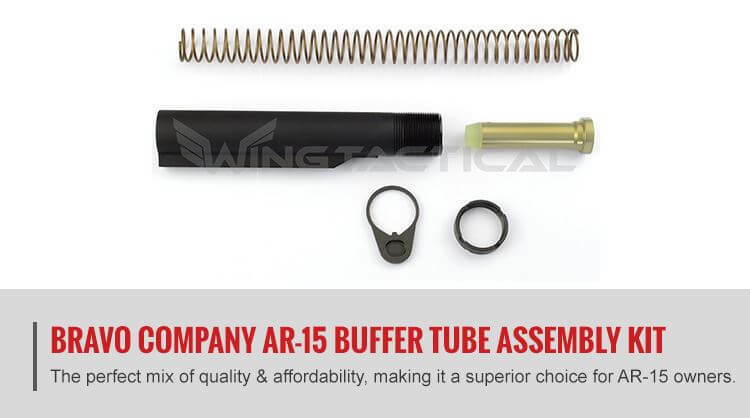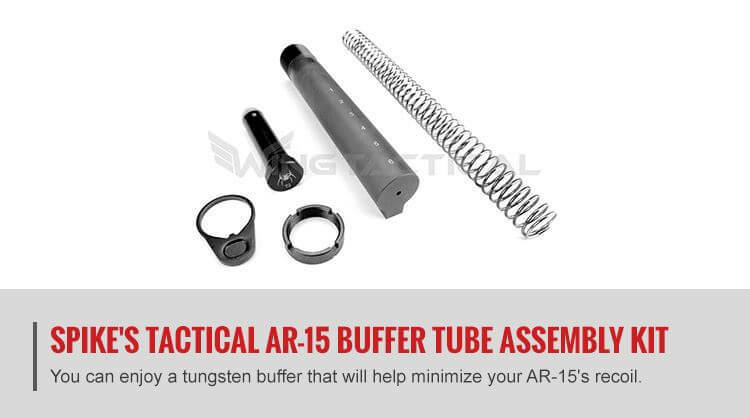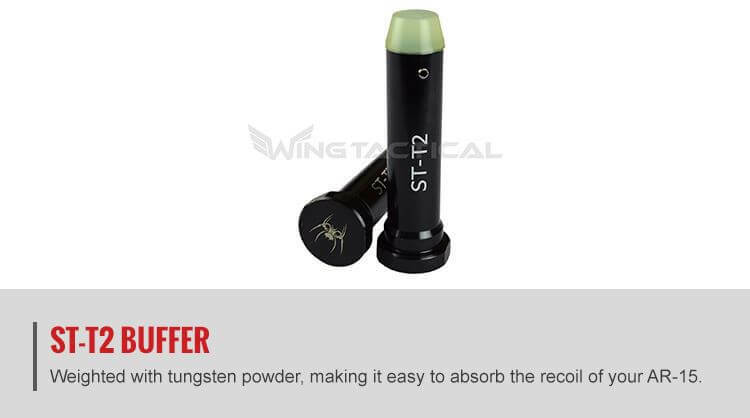Maintaining the quality and performance of your AR-15 rifle requires a top-notch buffer. Unfortunately, not all buffer options are created equal, which means you may need to conduct plenty of research to discover the best buffer weight for your AR-15.
NORC at the University of Chicago reported that 31 percent of U.S. households owned a gun in 2014. Meanwhile, the AR-15 remains a popular choice for rifle owners, and this gun boasts a proven reputation as a lightweight, well-constructed model.
So, what does it take to keep your AR-15 in top condition? You'll need to evaluate buffer spring types and buffer spring weight lengths and ensure your AR-15’s buffer is of the highest quality.
Examining buffer types and buffer spring lengths often challenges even the most studious AR-15 owner, but we're here to help you find the right AR-15 buffers and buffer springs quickly and effortlessly.
Table Of Contents:
-
HOW DO I CHOOSE THE RIGHT BUFFER FOR MY AR-15?
-
WHAT BUFFER WEIGHT OPTIONS DO I HAVE?
-
WHICH MATERIALS ARE USED TO CREATE AR-15 BUFFERS?
-
WHY DO I NEED TO REPLACE MY AR-15 BUFFER SPRINGS?
-
HOW DO I ENSURE THAT MY AR-15'S BUFFER SPRING IS WORKING PROPERLY?
-
WHAT ARE SOME OF THE BEST BUFFER AND AR-15 BUFFER SPRING OPTIONS AVAILABLE?
HOW DO I CHOOSE THE RIGHT BUFFER FOR MY AR-15?

The buffer is a very important component if you want a smoother operating AR, but it is only part of the recoil management system. The AR-15 gas system differs from rifle to rifle, and many other parts have to be considered when looking for the "perfect" buffer for an AR-15 buffer for your custom build. For example, the BCG weight, barrel length, gas block, gas port size on the barrel, gas tube length, and what kind of ammo you use. There is no absolute answer to "Which is the perfect buffer for my AR-15?" Most AR owners will have to try out one or two before they find the right buffer for their build.
The AR system requires the right amount of gas to cycle perfectly. Being a bit over-gassed can ensure the gun cycles reliably, even in extreme conditions. However, it will also increase felt recoil and excessive wear on internal parts. If there is too little gas, your AR will not cycle properly. This might lead to failure to extract, failure to feed, or the bolt not locking back on the last round. While there is no book answer to what buffer for AR-15 is perfect for you, at least we can help you decide what might be the better option when you are buying your next buffer, so you don't have to waste money on 3 or 4 buffers before getting the right one.
A factory AR-15 will normally have a gas port drilled a bit bigger than it should be to ensure enough gas to cycle the gun. While being a bit over-gassed helps reliability, it is not always beneficial or even desirable. This is especially true for recreational use or for competition where a lighter recoil and smoother operating system are desired. That being said, upgrading to an H or H2 buffer for an AR-15 buffer on a factory rifle will most likely reduce felt recoil and muzzle movement and prevent internal parts from wearing immaturely.
Here is some money-saving-advice before buying a new buffer:
- If your existing buffer is not giving you any problems, such as excessive recoil, you can stick with the same AR-15 buffer spring weight.
- Does your buddy have a buffer with a different buffer weight than yours? Take your buddy to the range and try out his buffer to determine if you need a heavier or lighter buffer.
WHAT BUFFER WEIGHT OPTIONS DO I HAVE?
Most buffers may look the same at first glance, but you’re sure to find many different types available that meet your needs.
Some of the most common buffers for AR-15s on the market include:
- Carbine Buffer - This consists of three steel weights, usually weighing about 3.0 oz. in weight.
- Heavy (H) Buffer - An H buffer boasts a combination of one tungsten and two steel weights and commonly weighs around 3.8 oz.
- H2 Buffer - This buffer features the same design as the H buffer but weighs around 4.6 oz. on average.
- H3 Buffer - Similar to the H buffer and H2 buffer, the H3 buffer includes three tungsten weights and often weighs about 5.4 oz.
- Rifle Buffer - A rifle buffer includes five steel weights and a steel spacer, totaling around 5.0 oz. This buffer is mostly used in a rifle-length buffer tube.

Finding the right AR-15 buffer spring weight combined with the right buffer for an AR-15 guarantees you'll be able to reduce your rifle’s recoil and, ultimately, enjoy a better experience every time you use it.
However, it’s important to note that you must maintain your AR-15's buffer to ensure the bolt carrier can reload your rifle properly.
WHICH MATERIALS ARE USED TO CREATE AR-15 BUFFERS?
We've already established that no two AR-15 buffers are identical, and as such, many materials are used to construct buffers.
The most common materials that are used to create AR-15 buffers include:
- Aluminum - The lightest option available, a single aluminum buffer weight frequently weighs 0.22 oz. on average.
- Steel - Weighing in around 0.64 oz., steel buffers are proven to last and deliver exceptional value for AR-15 owners.
- Tungsten - A tungsten buffer weight commonly weighs around 1.5 oz. on average and is the heaviest option available.
Steel and tungsten remain the most frequently used AR-15 buffer, as these materials are both heavy and dense. Thus, steel and tungsten represent great choices for AR-15 buffer spring weights.
WHY DO I NEED TO REPLACE MY AR-15 BUFFER SPRINGS?
With buffer springs, you can ensure that your AR-15 will continue to perform consistently. These springs are necessary to guarantee your AR-15 fires properly, and without them, you will not be able to fire your AR-15.
AR-15 buffers provide a very simple yet important purpose in a rifle. Each time the gun is cocked or a round is fired, the bolt carrier has to follow through an action to load a round into the chamber. When the bolt carrier is either cocked back or pushed back, it hits the buffer and buffer spring inside the buffer tube. This action pushes the bolt carrier forward to pick up a round.
Furthermore, master gunsmith Patrick Sweeney tells GunDigest that a buffer spring acts as an extra weight that enables an AR-15's carrier and bolt to move back into the correct position after a rifle is fired. This spring in the AR-15 buffer usually consists of steel alloy, Sweeney points out, and will need to be replaced as a spring shortens over an extended period.
HOW DO I ENSURE THAT MY AR-15'S BUFFER SPRING IS WORKING PROPERLY?
With your AR-15's buffer springs, it’s always better to err on the side of caution. Therefore, regular AR-15 maintenance is essential, as this will allow you to devote the necessary time and resources to guarantee your rifle performs as needed.
Here are three tips you can use to guarantee the buffer in an AR-15 to perform consistently:
1. Evaluate Your AR-15's Buffer and Spring
How will you know if your AR-15's buffer and spring are performing well if you do not examine them? With the right tools and know-how, you can remove your spring and AR-15 buffer spring weight for closer examination whenever you'd like.
Sweeney offers the following instructions to ensure you can remove your AR-15's buffer and spring quickly and safely:
“To remove the AR-15 buffer and spring, push the rear takedown pin across and hinge-open the action. At the rear inside of the lower is a small plunger at the face of the buffer. Depress the plunger and the spring will push the buffer out of the tube. Once the head of the buffer clears the plunger, grab the buffer and pull it and the spring out of the tube. It may take some wiggling to get it past the hammer (which should be cocked), but it does come out.”
Getting an up-close look at your rifle's buffer and spring enables you to guarantee the quality of these components.
2. Measure the Springs
Unfortunately, your AR-15’s buffer springs will shorten after prolonged use. This means that, as your rifle's springs shorten, you should work to replace these springs sooner rather than later.
“When a spring has gotten much shorter than the starting length, replace it,” Sweeney recommends. “As long as a rifle spring is more than 12 inches long, and a carbine spring more than 10 inches long, they are still serviceable. When they have shortened to those lengths or shorter, replace them.”
Measuring the springs can be fast and simple for even a novice AR-15 owner.
The springs for your AR-15's rifle and carbine feature the same diameter. Sweeney notes the rifle springs usually have between 41 and 43 coils, while the carbine springs boast 37 to 39 coils on average. And if any of the measurements seem shorter than expected, it may be a good time to replace your AR-15 buffer spring.
3. Study the Coils
Remember, rifle and carbine springs are NOT interchangeable. Thus, you'll want to count these springs separately.
You also will want to resist the temptation to take shortcuts as you study the coils, as this could result in serious problems with your AR-15’s performance.
“While the lengths and number of coils would seem close enough that, in an emergency, you could get by, resist the temptation,” Sweeney points out. “‘Emergencies’ tend to linger on, as the equipment is ‘obviously’ doing fine. It is hard on the rifle or carbine to be ‘getting by’ with the wrong spring.”
Of course, investing in the right buffer for an AR-15 can make a world of difference for AR-15 owners, too.
Sweeney states that if a carbine works correctly with a conventional buffer, you may be best served to leave the buffer alone for the time being. On the other hand, if you experience problems firing your rifle, you should consider replacing all of your rifle’s carbines with H or H2 buffers immediately.
And under no circumstances should you ever consider exchanging AR-15 buffers.
"The rifle buffer is too long, and firing a carbine with a rifle buffer in it will cause the buffer tail to strike the end of the tube at higher than designed velocities. If you are lucky, the result will be that the carrier key screws shear off. If the screws do not shear off in time, the lower receiver will crack at the buffer tube threads," Sweeney notes. "Install the proper AR-15 buffer, and avoid the hassles of a new lower to correct the mistake."
WHAT ARE SOME OF THE BEST BUFFER AND AR-15 BUFFER SPRING OPTIONS AVAILABLE?
Here are three top-rated buffer spring systems and kits that likely will serve you well:
1. JP ENTERPRISES SILENT CAPTURED SPRING AR-15 BUFFER SYSTEM (GEN 2)
For those who want to eliminate buffer and spring noises, the JP Enterprises Silent Captured Spring AR-15 Buffer System (GEN 2) represents an ideal choice.
This option features a Silent Captured Spring system designed to dramatically reduce noise whenever you use your AR-15. The system boasts highly polished parts, guaranteeing smooth and precise operation day after day. Also, this AR-15 buffer system is compatible with both standard components as well as the low-mass bolt carrier and adjustable gas system from JP Enterprises for added flexibility.

Making the most of your AR-15 shooting experience can be difficult, especially if you're forced to deal with excessive operational noise. But with the JP Enterprises Silent Captured Spring AR-15 Buffer System, you'll be better equipped to enjoy a quieter, smoother shooting experience at any time.
2. BRAVO COMPANY AR-15 BUFFER TUBE AND SPRING ASSEMBLY KIT (MIL-SPEC)

With its carbine action spring, carbine standard buffer assembly, and other great features, the Bravo Company AR-15 Buffer Tube Assembly Kit (Mil-Spec) delivers the perfect mix of quality and affordability, making it a superior choice for AR-15 owners.
This assembly kit is a terrific option for law enforcement officers, shooting sports competitors and other AR-15 owners. It includes a buffer tube that consists of 7075-T6 aluminum for unparalleled quality, along with a durable steel spring for your AR-15 buffer that won’t wear out quickly. In addition, the AR-15 buffer spring weight can be adjusted immediately to ensure you can minimize the impact of your AR-15’s recoil.
Take advantage of the Bravo Company AR-15 Buffer Tube Assembly Kit, and you can reap the benefits of a buffer tube assembly kit that includes everything you’ll need to optimize the performance of your AR-15.
3. SPIKE'S TACTICAL AR-15 BUFFER TUBE ASSEMBLY KIT (MIL-SPEC)

With Spike's Tactical AR-15 Buffer Tube Assembly Kit (Mil-Spec), you can enjoy a tungsten buffer that will help minimize your AR-15's recoil any time you fire it.
4. SPIKE'S TACTICAL T2 BUFFER

This assembly kit offers an ST-T2 buffer that is weighted with tungsten powder, making it easy to absorb the recoil of your AR-15. With the kit's spring made of 17-7 stainless steel, you'll be able to reduce the risk of binding that sometimes occurs with subpar springs.
Plus, the kit includes a 7075-T6 aluminum AR-15 buffer tube with six holes, guaranteeing you'll be able to adjust the stock accordingly. This tube even boasts a dry film lube for advanced corrosion protection.
When it comes to your AR-15, why should you be forced to settle for anything less than perfection? Instead, select Spike's Tactical AR-15 Buffer Tube Assembly Kit, and you can enhance your rifle's performance and reduce its recoil day after day.
FIND THE PARTS YOU NEED AT WING TACTICAL
Clearly, many great kits and systems for buffers for AR-15s are available, making it simple for you to maximize the value of your AR-15. With support from the experts at Wing Tactical, you should have no trouble finding the right buffer spring products any time you visit our website.
For years, we’ve provided the best AR-15 accessories at affordable prices, empowering AR-15 owners to ensure their rifles can be used consistently. We strive to serve our clients in any way we can and provide numerous gun tools, survival gear, and other range gear to help create the best customer experience possible.
Lastly, we back all of our products with a 30-day guarantee. If you feel unsatisfied with a product, you can return it to us for a full refund.
Choose Wing Tactical for your AR-15 buffer, AR-15 buffer spring weights, and other supplies. By doing so, you can enjoy the benefits an excellent supplier of AR-15 products and accessories provides.